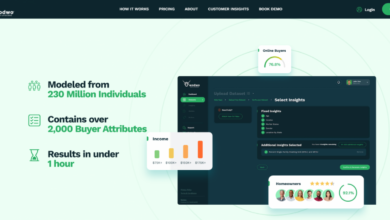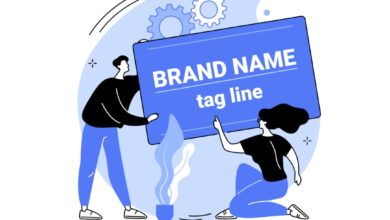
Good Branding in Web Design A Crucial Element
Good branding in web design isn’t just about pretty pictures; it’s the foundation upon which a successful online presence is built. It’s about crafting a unique identity that resonates with your target audience, forging a connection that transcends mere aesthetics. We’ll dive into the core principles, exploring visual elements, user experience, compelling content, and responsive design – all crucial components of a winning brand strategy online.
This post unpacks how to create a brand that not only looks good but also performs exceptionally well, attracting and retaining customers.
From choosing the perfect color palette to crafting a consistent brand voice, we’ll examine how every design decision contributes to the overall brand experience. We’ll also look at practical examples, highlighting what makes some websites truly memorable and how you can apply these strategies to your own projects. Get ready to transform your website from a simple collection of pages into a powerful brand ambassador!
Defining Effective Web Design Branding
Effective web design branding goes beyond just a pretty logo; it’s about creating a cohesive and memorable online experience that resonates with your target audience and accurately reflects your brand’s personality and values. It’s the crucial link between your online presence and your overall brand strategy, ensuring consistency and strengthening recognition.A strong web design brand utilizes visual elements, messaging, and user experience to create a unified and impactful impression.
This includes consistent use of color palettes, typography, imagery, and tone of voice across all web pages. It’s about crafting a digital identity that is easily recognizable and memorable, ultimately driving user engagement and loyalty.
Examples of Effective Web Branding, Good branding in web design
Several websites exemplify excellent branding. Consider Apple’s website: its minimalist design, clean typography, and high-quality product photography create a sense of sophistication and premium quality, perfectly aligning with the brand’s image. Conversely, the bright, playful design and interactive elements of the LEGO website effectively target its younger demographic, creating an engaging and fun online experience. The consistent use of bold colors and playful typography on the LEGO site is a direct reflection of the brand’s fun and creative product line.
In contrast, the sophisticated and minimalist design of Apple’s website reflects the premium nature of their products. Both approaches are highly effective because they are perfectly tailored to their respective target audiences.
Three Approaches to Building a Brand Identity for a Website
Building a strong brand identity requires a strategic approach. Three distinct methods exist:
First, a market research-driven approach involves extensive analysis of your target audience, competitors, and industry trends. This informs the development of a unique brand identity that differentiates you from the competition and appeals to your ideal customer. This data-driven approach ensures that the branding resonates with the intended audience and effectively communicates the brand’s value proposition.
Second, a brand personality-driven approach focuses on defining the core values and personality of your brand. This approach prioritizes crafting a visual and textual identity that accurately reflects these attributes. This might involve selecting a specific color palette that evokes feelings of trust or creativity, or using a specific font that conveys professionalism or playfulness. The focus is on making the brand feel authentic and relatable.
Third, a competitor analysis-driven approach involves studying successful brands in your industry to identify best practices and areas for differentiation. This method allows you to learn from the successes and failures of others while still maintaining a unique brand identity. This involves identifying what works well for competitors and adapting successful strategies, while simultaneously finding ways to differentiate yourself and stand out from the crowd.
Hypothetical Brand Identity: “EcoFlow,” a Sustainable Coffee Company
Imagine “EcoFlow,” a fictional sustainable coffee company. Its brand identity would center around natural elements and a commitment to environmental responsibility.
Visual Elements: The logo would feature a stylized leaf incorporated into a coffee bean shape, using earthy tones of green and brown. The website would utilize high-quality photography showcasing the coffee beans’ origins and the sustainable farming practices. The typography would be clean and modern, using fonts that evoke a sense of naturalness and sophistication.
Messaging: The website’s messaging would emphasize the company’s commitment to sustainable sourcing, fair trade practices, and environmentally friendly packaging. The tone would be warm, inviting, and informative, highlighting the quality of the coffee and the positive impact of supporting EcoFlow. The overall message would aim to resonate with environmentally conscious consumers who appreciate high-quality coffee.
Visual Aspects of Branding
Creating a strong brand identity online hinges heavily on visual elements. A well-designed website isn’t just about functionality; it’s about communicating your brand’s personality, values, and message effectively through carefully chosen visuals. These visuals work together to create a cohesive and memorable experience for your users, ultimately influencing their perception and interaction with your brand.
Color Palettes and Brand Identity
Color psychology plays a significant role in shaping user perception. Different colors evoke different emotions and associations. A well-chosen color palette can instantly communicate your brand’s personality and target audience. For example, a vibrant, energetic palette might suit a youth-oriented brand, while a sophisticated, muted palette might be more appropriate for a luxury brand. The consistency of your color scheme across your website is crucial for maintaining a unified brand identity.
| Color Scheme | Example Colors | Psychological Impact | Brand Examples |
|---|---|---|---|
| Warm (Analogous) | Reds, oranges, yellows | Energy, excitement, warmth, comfort | Food brands, children’s products |
| Cool (Analogous) | Blues, greens, purples | Calmness, trust, serenity, sophistication | Technology companies, healthcare providers |
| Complementary | Blues and oranges, reds and greens | High contrast, visual interest, excitement | Fashion brands, entertainment companies |
| Monochromatic | Variations of a single color (e.g., different shades of blue) | Sophistication, elegance, consistency | Luxury brands, corporate websites |
Typography and Brand Cohesion
Typography is more than just choosing fonts; it’s about selecting typefaces that accurately reflect your brand’s personality and enhance readability. Font pairings should complement each other, creating a visually appealing and harmonious experience. For example, a pairing of a clean sans-serif font (like Open Sans) with a more decorative serif font (like Playfair Display) can create a sophisticated yet approachable feel.
Conversely, a pairing of two bold sans-serif fonts (like Montserrat and Roboto) might convey a modern and energetic brand personality. Consistency in font usage across your website is essential for a unified brand experience.
Imagery and Brand Perception
High-quality imagery significantly impacts brand perception. Images should be carefully chosen to reflect your brand’s values and resonate with your target audience. Images should be visually appealing, high-resolution, and relevant to your content.
Here are descriptions of images suitable for different brands:
Technology Company: A clean, minimalist image of a futuristic cityscape at night, with glowing skyscrapers and technological elements subtly integrated into the design. This image conveys innovation, progress, and a forward-thinking approach.
Food Blog: A close-up, mouthwatering shot of a freshly baked pastry, with warm lighting and visible textures. This image evokes feelings of warmth, comfort, and deliciousness, appealing to the senses and creating a desire for the food featured.
Fashion Retailer: A stylish, fashion-forward image of a model wearing the latest clothing collection, set against a modern and minimalist backdrop. This image conveys trendiness, sophistication, and aspirational lifestyle, attracting the target audience.
Key Visual Elements for Brand Consistency
Maintaining visual consistency across your website is paramount for establishing a strong brand identity. Here are five key visual elements to consider:
Before creating your website, it is essential to carefully consider these visual elements to ensure a consistent and impactful brand presence. Ignoring these elements can lead to a disjointed and confusing user experience.
- Color Palette: Maintain a consistent color scheme throughout your website, using brand colors for key elements like buttons, headings, and links.
- Typography: Use a limited number of fonts, sticking to your chosen brand fonts for headings, body text, and other elements.
- Imagery: Use high-quality images that are consistent in style and tone with your brand’s overall aesthetic.
- Layout and Design: Maintain a consistent layout and design across all pages of your website, ensuring a unified user experience.
- Logo and Branding Elements: Ensure your logo and other branding elements (e.g., icons, patterns) are used consistently and prominently throughout your website.
User Experience (UX) and Branding: Good Branding In Web Design
A website’s success hinges not just on its visual appeal, but crucially on how easily and enjoyably users can navigate and interact with it. A seamless user experience (UX) directly translates into a stronger brand perception, fostering loyalty and driving conversions. Ignoring UX is like building a beautiful storefront with a locked door – the potential is there, but it’s inaccessible.Intuitive navigation is the backbone of a positive brand experience.
When users can effortlessly find what they need, they associate that ease with the brand itself. This positive association strengthens their perception of the brand as efficient, reliable, and user-focused. Conversely, a frustrating navigation experience can quickly erode trust and lead to abandonment.
Intuitive Navigation’s Contribution to Positive Brand Experience
A well-designed navigation system, whether through a clear menu structure, intuitive search functionality, or strategically placed calls-to-action, significantly enhances user satisfaction. Imagine a clothing website with a simple, categorized menu allowing users to quickly filter by size, color, and style. This efficient navigation creates a positive association with the brand, suggesting competence and user-centric design. This contrasts sharply with a website where users struggle to find products, leading to frustration and a negative brand perception.
The ease of use directly impacts the user’s overall experience, shaping their opinion of the brand.
Common UX Mistakes Negatively Impacting Brand Perception
Several common UX design flaws can severely damage a brand’s reputation.
- Poor Site Search: A broken or inadequate search function frustrates users and prevents them from finding what they need. This reflects poorly on the brand’s competence and attention to detail.
- Inconsistent Design: A lack of consistency in design elements, such as button styles, fonts, or color palettes, creates a disjointed experience, making the website feel unprofessional and undermining brand trust.
- Slow Loading Times: Slow loading speeds lead to frustration and abandonment. Users are less likely to engage with a brand that delivers a slow, unresponsive experience, impacting their overall perception of the brand’s efficiency and professionalism.
UX Design Principles Comparison: Apple vs. Amazon
Apple and Amazon, while operating in different sectors, exemplify contrasting yet effective UX approaches. Apple prioritizes minimalist design and intuitive interactions, focusing on a seamless and aesthetically pleasing experience. Their products and websites are known for their simplicity and elegance. Amazon, on the other hand, emphasizes functionality and efficiency, prioritizing speed and ease of access to a vast product catalog.
While aesthetically different, both brands successfully integrate their UX principles with their overall branding, creating a consistent and memorable experience for users. Apple’s focus is on creating a premium, refined experience, while Amazon’s is on maximizing efficiency and providing a vast selection.
User Flow Diagram for a Hypothetical E-commerce Website
This diagram illustrates a simplified user flow for a hypothetical e-commerce website selling handcrafted jewelry, emphasizing brand experience at each step.Imagine a website called “ArtisanGems.”
1. Homepage
The homepage features high-quality images of jewelry, a clear and concise navigation menu, and a prominent call-to-action encouraging browsing. The design is clean and elegant, reflecting the handcrafted nature of the products. (Brand experience: First impression – showcasing quality and craftsmanship.)
2. Product Browsing
Users can easily browse by category (e.g., necklaces, earrings, bracelets) or use the search function. Detailed product descriptions and high-resolution images are provided. (Brand experience: Emphasis on detail and product quality.)
3. Product Page
Each product page includes detailed descriptions, multiple high-quality images, customer reviews, and sizing information. The design is consistent with the homepage, reinforcing the brand identity. (Brand experience: Builds trust through transparency and information.)
4. Shopping Cart
The shopping cart is straightforward and allows users to easily review items, adjust quantities, and proceed to checkout. (Brand experience: Simple and efficient checkout process.)
5. Checkout
The checkout process is streamlined, with clear instructions and multiple payment options. (Brand experience: Seamless and secure transaction.)
6. Order Confirmation
Users receive an immediate order confirmation email with tracking information. (Brand experience: Reinforces positive interaction and builds trust.)
7. Post-Purchase
Follow-up emails might include shipping updates and thank-you messages. (Brand experience: Personalized and caring touch.)This user flow demonstrates how each step contributes to a positive brand experience, from initial browsing to post-purchase communication, consistently reinforcing the “ArtisanGems” brand identity of quality, craftsmanship, and customer care.
Content and Messaging in Branding
Crafting compelling website copy is more than just stringing words together; it’s the art of translating your brand’s essence into a language your audience understands and connects with. Effective messaging is the cornerstone of a successful web presence, weaving together visual design and user experience to create a cohesive and memorable brand identity. It’s about communicating your brand values, mission, and unique selling propositions in a way that resonates deeply with your target demographic.Website content should be meticulously crafted to ensure every word contributes to the overall brand narrative.
This requires a deep understanding of your target audience and the specific message you want to convey. The tone, style, and overall message must be consistent across all platforms and channels to avoid confusion and maintain a strong brand identity. Inconsistency can dilute your brand’s message and create a fragmented experience for the user.
Compelling Website Copy Examples
Effective website copy goes beyond simply describing products or services. It should evoke emotion, build trust, and inspire action. Consider these examples: A sustainable clothing brand might use copy that emphasizes ethical sourcing and eco-friendly practices, such as: ” Crafted with care for people and planet. Our clothes are made from sustainably sourced materials, ensuring both quality and environmental responsibility.” Conversely, a tech startup might highlight innovation and problem-solving with phrases like: ” We’re revolutionizing [industry] with our cutting-edge technology, simplifying complex processes and empowering users to achieve more.” These examples demonstrate how specific language can directly reflect and reinforce brand values.
Note the use of strong verbs and evocative language to create a more engaging experience.
Consistent Brand Voice and Tone
Maintaining a consistent brand voice and tone across all website content is paramount. Imagine a luxury car brand using informal slang on its website – the dissonance would be jarring and damage brand perception. Consistency ensures a unified brand experience, building trust and recognition. This requires establishing clear guidelines for writing style, vocabulary, and overall tone. For example, a formal brand might favor sophisticated language and a professional tone, while a playful brand might adopt a more casual and humorous approach.
This consistency should extend to blog posts, product descriptions, social media updates, and email marketing campaigns. Internal style guides can help maintain consistency across different teams and content creators.
Creating Engaging and Informative Content
Engaging and informative content is crucial for keeping visitors on your website and encouraging conversions. This involves using a variety of content formats – blog posts, videos, infographics, case studies – to cater to different learning styles and preferences. The content should be well-structured, easy to read, and visually appealing. Using high-quality images, videos, and interactive elements can enhance engagement.
Remember to always prioritize providing value to the user; answer their questions, solve their problems, and provide them with useful information relevant to their needs and interests. This approach builds trust and strengthens brand loyalty.
Storytelling and Brand Connection
Storytelling is a powerful tool for building a deeper connection with website visitors. By sharing your brand’s story – its origins, mission, and values – you can create an emotional connection that goes beyond mere transactions. A compelling narrative humanizes your brand, making it more relatable and memorable. This can be achieved through blog posts that detail the brand’s journey, testimonials from satisfied customers, or even short videos showcasing the people behind the brand.
Effectively weaving a narrative into your website content helps visitors understand your brand on a deeper level, fostering loyalty and advocacy.
Responsive Design and Branding
In today’s multi-device world, responsive design isn’t just a nice-to-have; it’s a crucial element of effective branding. A website that looks great on a desktop but crumbles on a mobile phone severely undermines your brand image, creating a frustrating and inconsistent experience for your users. Maintaining a consistent brand identity across all platforms is paramount for building trust and recognition.Responsive design ensures your brand message and visual identity remain consistent regardless of the device used to access your website.
This consistency strengthens brand recognition and reinforces your brand’s overall message, ensuring a unified user experience. A fragmented experience, on the other hand, can dilute your brand’s impact and confuse potential customers.
Maintaining Brand Consistency Across Devices
Achieving seamless brand consistency across different screen sizes requires careful planning and execution. This involves using a flexible grid system that adapts to different screen resolutions, ensuring all elements scale proportionally. High-quality images and responsive image formats (like WebP) are crucial for maintaining visual appeal without sacrificing loading speed. Furthermore, the typography should be adaptable, using responsive font sizes and line heights that remain legible across all devices.
Finally, consistent brand colors, logos, and overall design language must be meticulously applied across all breakpoints. Failure to do so leads to a disjointed and unprofessional brand image.
Ensuring a Seamless Brand Experience Across Different Screen Sizes
A seamless brand experience transcends mere visual consistency. It also encompasses the functionality and user journey. Navigation should be intuitive and easy to use on all devices. Call-to-action buttons must be clearly visible and easily accessible, regardless of screen size. Loading times should be optimized to provide a quick and responsive experience, even on slower connections.
This requires careful consideration of image optimization, code minification, and efficient server-side processing. Testing your website on various devices and screen sizes is essential to identify and address any inconsistencies or usability issues before launch. A/B testing different layouts can help optimize the user experience further.
Mobile-First Approach Emphasizing Brand Elements
Designing with a mobile-first approach means prioritizing the mobile user experience first. This ensures that the core elements of your brand are clearly communicated even on the smallest screens. Starting with a mobile-friendly layout simplifies the design process and helps to avoid unnecessary complexity. Key brand elements like the logo, color palette, and typography should be prominent and easily recognizable.
Navigation should be streamlined and intuitive, often employing a hamburger menu for efficient space management. Call-to-actions should be strategically placed and designed for optimal tappability. For example, a company selling handcrafted jewelry could showcase their best-selling pieces with high-quality, zoomed-in images on mobile, emphasizing the detail and craftsmanship, while also maintaining easy access to their shop page.
Comparison of Responsive Design Implementations
Let’s compare the responsive design of two hypothetical e-commerce websites: “ShopA” and “ShopB”. ShopA utilizes a simple, clean design with a clear hierarchy of information. Its responsive implementation seamlessly adapts its layout across different screen sizes, maintaining a consistent brand identity and user experience. Navigation is intuitive on all devices, and product images are optimized for fast loading.
ShopB, on the other hand, uses a cluttered design with an overly complex layout. Its responsive implementation is less effective, with elements overlapping or becoming illegible on smaller screens. Navigation is confusing, and product images take a long time to load, resulting in a poor user experience. This stark contrast highlights the importance of careful planning and execution in responsive web design.
ShopA’s approach demonstrates a commitment to brand consistency and user satisfaction, while ShopB’s approach demonstrates the negative consequences of neglecting responsive design best practices.
Measuring Branding Success

Source: medium.com
So, you’ve poured your heart and soul (and maybe a hefty budget) into crafting a stunning website with killer branding. But how do you know if it’s actually working? Simply having a beautiful site isn’t enough; you need to measure its impact on your brand’s perception and bottom line. This is where understanding key metrics and employing effective tracking methods becomes crucial.
Let’s dive into the practical strategies for evaluating your website’s branding success.Key Metrics for Evaluating Website Branding Effectiveness are crucial for understanding how your brand resonates with your audience. By monitoring these metrics, you gain valuable insights into areas needing improvement and strategies that are working well.
Key Metrics for Website Branding Evaluation
A well-rounded approach involves tracking several key performance indicators (KPIs). These metrics provide a holistic view of your branding’s effectiveness, revealing both strengths and weaknesses. For example, a high bounce rate might indicate a disconnect between your brand messaging and user expectations, while a low conversion rate might point to issues in your call to action. Understanding these interrelationships is key to improving your overall branding strategy.
Consider tracking metrics such as website traffic, bounce rate, time on site, conversion rates, and social media engagement. Analyzing these metrics in conjunction with each other paints a much clearer picture than any single metric alone.
Tracking Brand Awareness and Engagement
Tracking brand awareness and engagement requires a multi-faceted approach. One effective method is to monitor brand mentions across various online platforms. This includes social media, forums, and review sites. Analyzing the sentiment associated with these mentions (positive, negative, or neutral) provides valuable insights into how your brand is perceived. Furthermore, tracking website analytics such as unique visitors, returning visitors, and page views can provide a quantitative measure of brand engagement.
For example, a high number of returning visitors suggests strong brand loyalty and positive brand perception. Tools like Google Analytics are invaluable for tracking these metrics.
Analyzing User Feedback for Brand Improvement
User feedback is invaluable for refining your branding strategy. Collecting feedback through surveys, online reviews, and social media comments offers direct insights into user perceptions. Qualitative feedback, such as comments and reviews, can reveal specific aspects of your branding that resonate (or don’t resonate) with your audience. Analyzing this feedback can help identify areas for improvement and ensure your brand aligns with user expectations.
For example, consistent negative feedback about a specific aspect of your website’s design or messaging can guide targeted improvements. The key is to actively solicit feedback and use it to inform your branding decisions.
Good branding in web design is all about creating a consistent and memorable experience for your users. This extends beyond your website, though; it’s crucial to maintain that same brand voice and visual identity across all platforms, including your video content. That’s why understanding how to leverage video marketing, like learning the ins and outs of getting it on with youtube , is vital for building a strong brand presence.
Ultimately, consistent branding across all channels strengthens your overall brand recognition and customer loyalty.
Actionable Steps to Enhance Brand Perception Based on Website Analytics
Analyzing website analytics can reveal areas for improvement in your branding. For instance, a high bounce rate on a specific landing page might indicate a problem with the page’s content or design. A low conversion rate might suggest your call to action isn’t compelling enough. Here are some actionable steps to enhance brand perception based on these insights:
- Optimize website content: Ensure your website’s content aligns with your brand messaging and resonates with your target audience. Use clear, concise language, and high-quality visuals.
- Improve website design: A visually appealing and user-friendly website enhances brand perception. Ensure your website is easy to navigate and visually consistent with your brand identity.
- Enhance user experience (UX): A positive user experience is crucial for building brand loyalty. Optimize your website for speed, accessibility, and mobile responsiveness.
- Strengthen call to action (CTA): A compelling CTA encourages users to take desired actions, such as making a purchase or signing up for a newsletter.
- Monitor and respond to user feedback: Actively solicit and respond to user feedback to show you value their opinions and are committed to improving their experience. This demonstrates brand transparency and responsiveness.
Last Point

Source: way2smile.ae
Ultimately, good branding in web design is a holistic process. It’s about creating a cohesive and memorable experience that resonates with your audience on every level—visual, emotional, and functional. By carefully considering every element, from color palettes and typography to user experience and content strategy, you can build a brand that not only attracts visitors but also fosters loyalty and drives conversions.
Remember, your website is more than just a digital storefront; it’s the face of your brand, and it should reflect your values, personality, and unique selling proposition.
Popular Questions
What’s the difference between branding and marketing?
Branding is about creating a unique identity and perception for your business. Marketing is about promoting that brand and reaching your target audience.
How long does it take to build a strong brand online?
Building a strong brand takes time and consistent effort. It’s an ongoing process of refinement and adaptation.
How much does professional web design branding cost?
Costs vary widely depending on the scope of the project and the designer’s experience. Expect to invest a significant amount for high-quality work.
Can I do my own web design branding?
You can attempt it, but professional designers offer expertise and efficiency. Consider your skills and time constraints.





